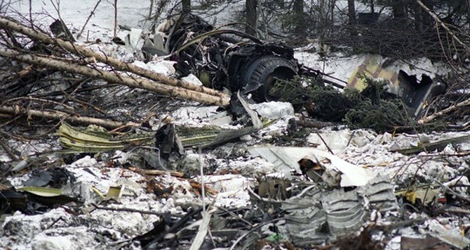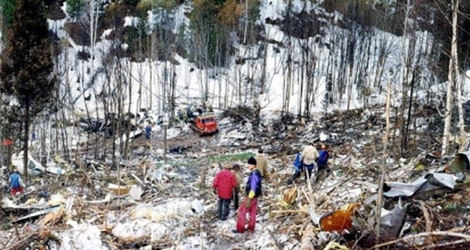On 22 March 1994, at 17:58 (here and throughout, times. will be given in hours and minutes UTC), 00:58 local time, an Airbus A31O-308 (registration F-OGQS) operated by the state subsidiary Russian Airlines flight AFL593 crashed 91 km. from Novokuznetsk Airport while on a scheduled passenger flight from Moscow to Hong Kong.
The accident occurred at night in good weather.
The aircraft was owned by the European Bank and registered in France. It had been leased by Aeroflot-Russian International Airlines.
The aircraft was operated by the state subsidiary Russian Airlines (RAL).
The Russian Airlines flight AFL593 was carrying three flight crew members, a cabin crew of nine, 63 passengers (including 25 foreigners), and 593 kg of mail and baggage.

Russian Airlines flight AFL593
The aeroplane took off from Sheremyetova Airport at 13:39. The mass at take-off was 145 tonnes, c. of g. 26.7%.
Thirty-nine minutes after take-off, the aeroplane reached an altitude of 10 100 m (here and throughout, altitudes and flight levels will be given in metres), and until 17:47 it continued on route without deviating from the flight plan at a speed of 530 km/h (here and throughout, lAS will be given in kmlh).
Seven minutes and twenty seconds after an exchange of radio messages with the Novokuznetsk controller, Russian Airlines flight AFL593 banked steeply to the right, stalled and entered a spin. At 17:58 the aeroplane struck the ground.
The accident occurred in the foothills of the Kuznetskii Ala-Tau, on the north-east slope of a 600 m hill with mixed forest cover and a 1.5 m layer of snow. The coordinates of the accident site are: 53°30’N 88°15’E.
The Russian Airlines flight AFL593 struck the side of the hill at an elevation of 400 m at a high vertical speed with landing gear, flaps and slats retracted and engines operating. The aeroplane was totally destroyed on impact and partly burned by the fire that broke out on impact with the ground. All crew members and passengers on board perished
The accident investigation was carried out by a Government Commission appointed under Russian Government order no. 370-P of 23 March 1994 and chaired by V. B. Efimov of the Ministry of Transport of the Russian Federation.
The official investigation into the circumstances and causes of the accident was carried out by a commission appointed under order no. DB-29 issued by the Director of the Air Transport Department of the Russian Ministry of Transport on 22 March 1994.
The Russian Airlines flight AFL593 disaster was caused by a stall, spin and impact with the ground resulting from a combination of the following factors:
The decision by PIC of Russian Airlines flight AFL593 to allow an unqualified and unauthorized outsider (his son) to occupy his duty station and intervene in the flying of the aeroplane.
- The execution of demonstration manoeuvres that were not anticipated in the flight plan or flight situation, with the PIC operating the autopilot while not at his duty station.
- Application by the outsider and the co-pilot of control forces that interfered with the functioning of the roll channel of the autopilot (and are not recommended in the A310 flight manual), thus overriding the autopilot and disconnecting it from the aileron control linkage.
- The co-pilot and PIC of Russian Airlines flight AFL593 failed to detect the fact that the autopilot had become disconnected from the aileron control linkage, probably because: The A310 instrumentation has no declutch warning. The provision of signals in accordance with the requirements of Airworthiness Standard NLGS-3, para. 8.2.7.3., and international recommended practices, could have enabled the crew to detect the disengaged autopilot in a timely manner.
- The co-pilot and PIC may have been unaware of the peculiarities of the declutching function and the actions to be taken in such a situation because of a lack of appropriate information in the flight manual and crew training programme;
- It was difficult for the co-pilot to detect the disengagement of the autopilot by feel, either because of the small forces on his control column or because he took changing forces to be the result of Eldar’s actions; The PIC was away from his position and distracted by the conversation with his daughter.
- A slight, unintentional further turn of the control wheel(s) following disengagement of the autopilot caused a right roll to develop.
- The PIC and co-pilot failed to detect the excessive right bank angle, which exceeded operating limits, and were late in re-entering the aircraft control loop because their attention was focussed on determining why the aircraft had banked to the right, a manoeuvre they interpreted as entry into a holding area with either no course line or with a new (false) course line generated on the navigational display.
- A strong signal indicating that the aeroplane had exceeded the allowable operating bank angle, taking account of the delay in recognizing and assessing the situation and making a decision, could in this situation have attracted the crew’s attention and enabled them to detect the bank at an earlier stage
- The aeroplane was subjected to buffeting and high angles of attack because the autopilot continued to perform its height-keeping function even after the actuator declutched and as the right roll developed, until the pilot disconnected it by overriding its longitudinal channel.
- Inappropriate and ineffective action on the part of the co-pilot, who failed to disconnect the autopilot and to push the control column forward when the buffeting occurred and the aeroplane entered an unusual attitude (high angles of attack andpitch).
- These actions, which caused the aeroplane to stall and spin
Download Report


0 Comments